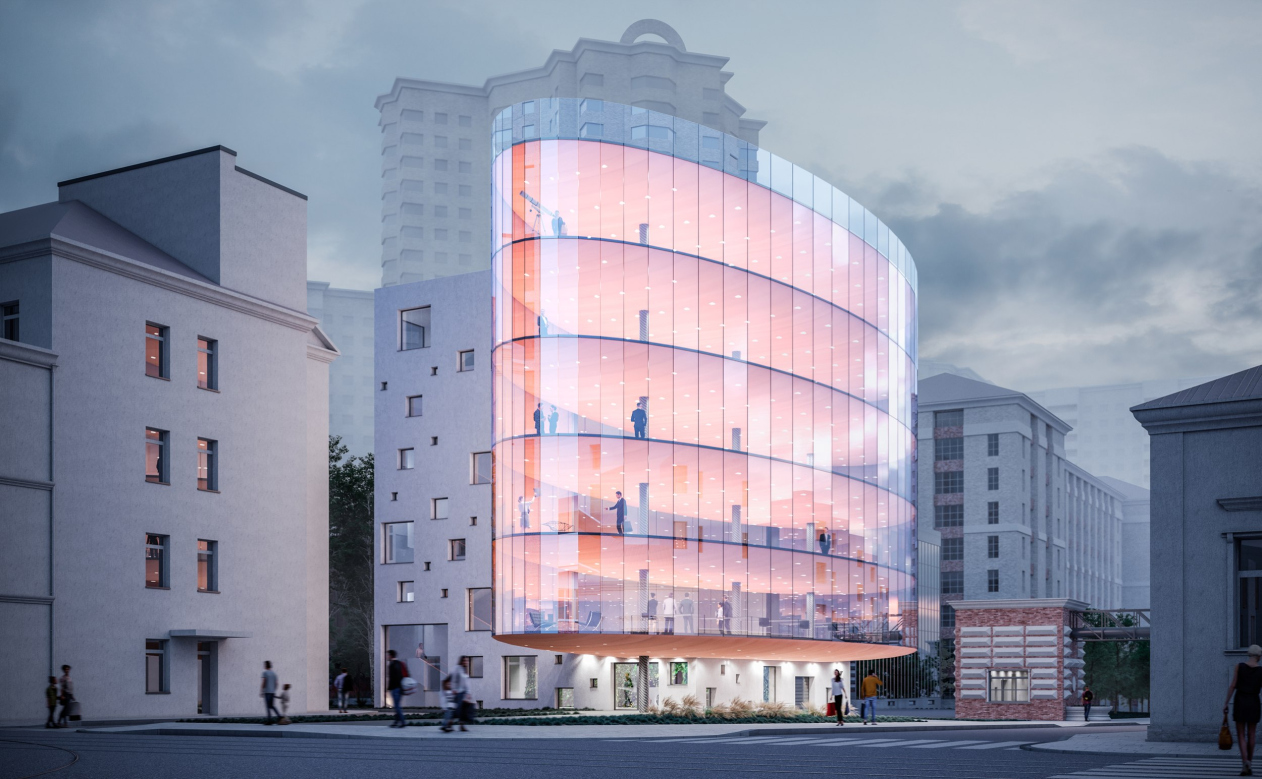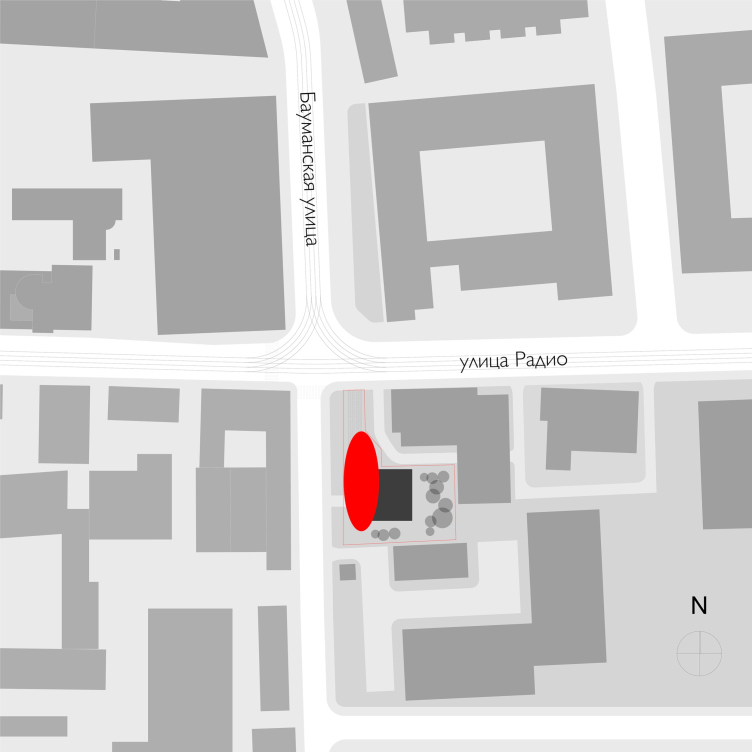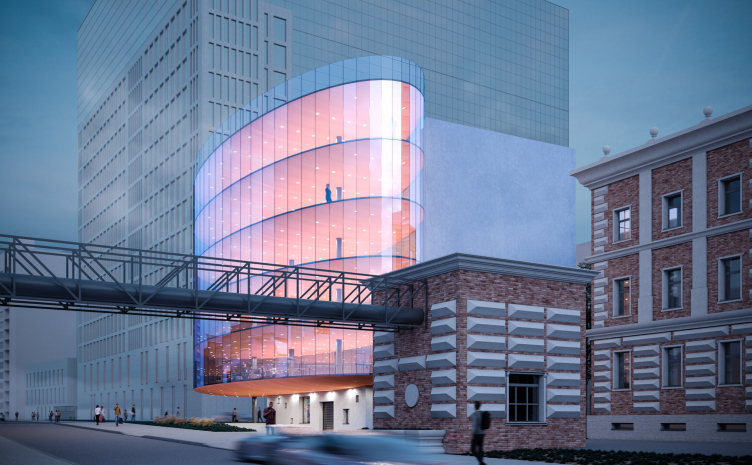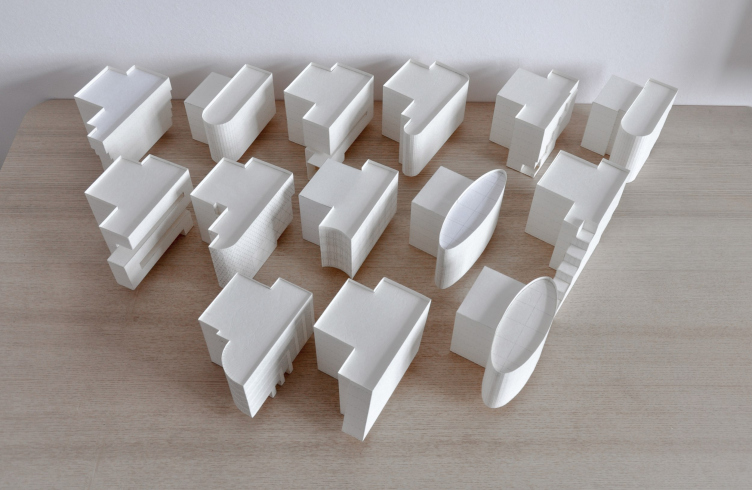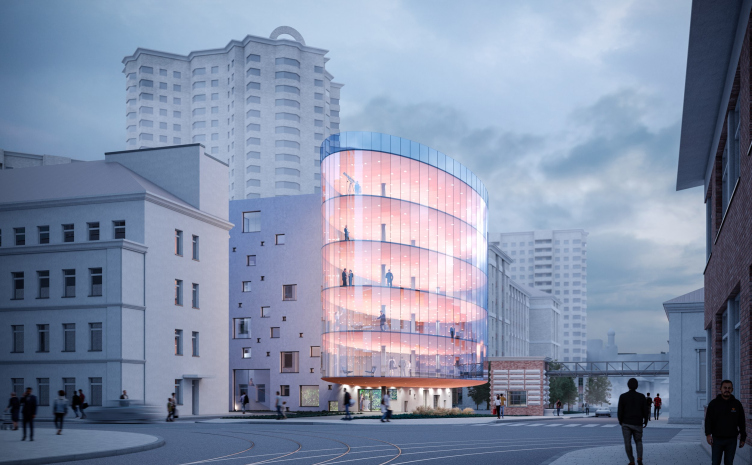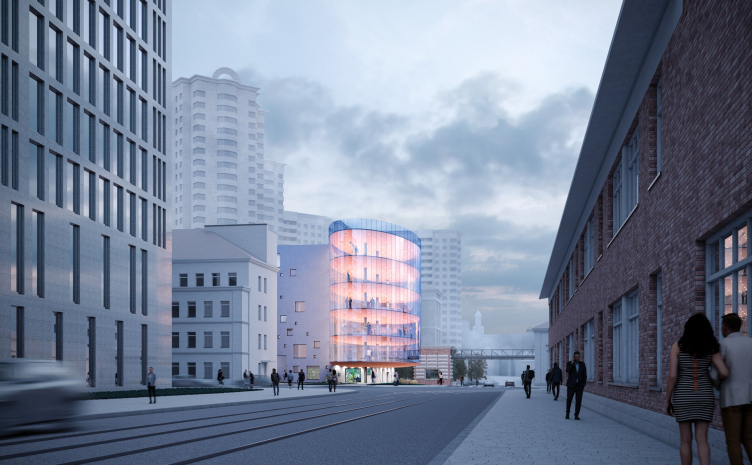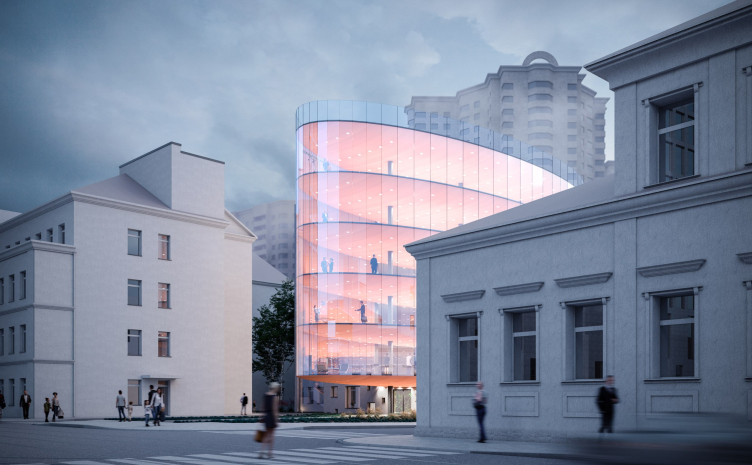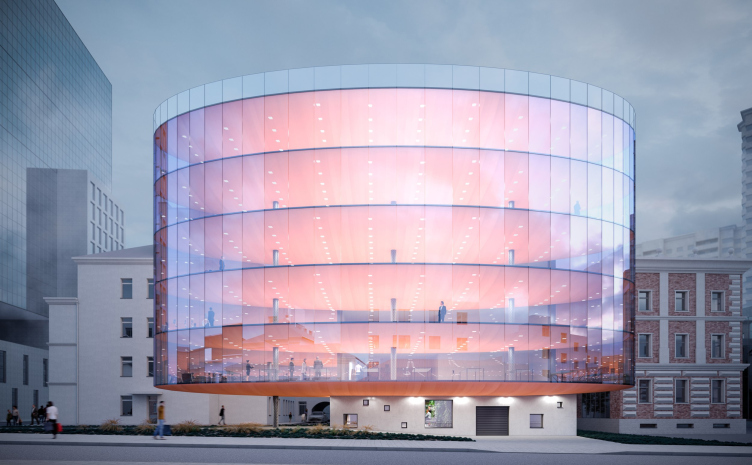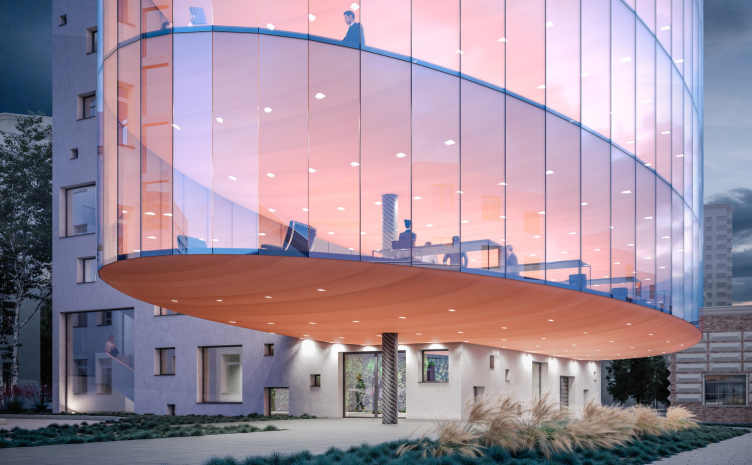Office building on the Radio Street
Copyright: © Mikhail Dmitriev architectural studio
Office building on the Radio Street
Copyright: © Mikhail Dmitriev architectural studio
The building was designed in very strained conditions. The first part of the constraint is created by various immovable communication lines, allowing construction on barely half of the plot, a sanitary setback from the nearby tuberculosis clinic, a height restriction of 22 meters, and even the architect’s self-imposed prohibition to obstruct the transformer booth of the adjacent “Tupolev Plaza-2” center designed by Dmitry Barkhin.
Office building on the Radio Street
Copyright: © Mikhail Dmitriev architectural studio
This led to the creation of a cantilever with a projection of 8.5 meters, the execution of which the architect himself mentions with some doubt, yet he seems to be reasonably hopeful – along with an automated parking lot situated in the closed half of the building for its entire height. There are only 5 parking places underground.
The second part of the constraint is outlined in the urban development plan of the land plot – besides the height restriction, it dictates designing the building in the style of the surrounding historical houses. Meanwhile, the architects are expected to deliver Class A offices. The project’s author, Mikhail Dmitriev, disagreed with this formulation and, after extensive searches for form, he proposed the boldest contemporary solution among the possible options.
Office building on the Radio Street
Copyright: © Mikhail Dmitriev architectural studio
This solution is accompanied by a rationale appealing to the diversity of the surrounding texture of the “German Settlement” and even the innovation inherent to it during the Petrine era. The examination includes Van Der Hulst Chambers, also known as Anna Mons Chambers, a beloved legend of these places, hidden but still alive behind the buildings of the former NIITP plant. Here we can see the mosaic nature of Moscow at its finest, along with the neighboring Central Institute of Aerohydrodynamics and Central Construction Bureau-29, Lilienthal Glider and Zhukovsky Museum, the Church of the Ascension on Gorokhovy Polye (attributed to Matvey Kazakov), standing in the distance along the Radio Street, and the vast, relatively recently reconstructed Investigative Committee building at the beginning of the street.
I want to agree with Mikhail Dmitriev here – Moscow is mosaic, and the German Settlement is particularly so, and Peter I bequeathed us to be bolder.
However, the most accurate statement is that the future business center stands at the intersection of Radio and Bauman streets; this place is a small but important urban “pivot”, and another vague stylization here would be a “blemish”. The proposed solution is definitely not that.
Office building on the Radio Street
Copyright: © Mikhail Dmitriev architectural studio
Office building on the Radio Street
Copyright: © Mikhail Dmitriev architectural studio
Of course, especially if it does shine as depicted on 3D renders.
In general, it looks like this: slightly convex “bulges” of wooden ceilings almost levitate within the outline of a semi-transparent glass shell, hanging in the air, resembling some kind of exploded view drawing, together forming a simple but mysteriously flickering shape.
It will be very interesting to see how this project will be executed. However, the architect promises to test the coating on mock-ups, and the warm tone is supported by the color of the suspended ceiling made of curved veneered sheets. Moreover, the aquarium effect with subtle glass joints running not only vertically but also between floors is captivating. According to the architect, all the joints have already been calculated, and engineering solutions have been thought out.
We thought out every detail of the design of the office building on Radio Street, since after the approval of the “architectural and urban planning solution”, adjustments to nodes and technical and economic indicators often lead to revision of fundamental design solutions.
The unique historical significance of the site and the diversity of the surrounding architectural context dictated a striking architectural gesture made nonetheless on a modest scale – much like the First Movement of Vivaldi’s “Winter”.
Our class “A” office building is located on a small plot of only 1100 m2, in the southern and eastern part of which the heating mains, electrical cables, water supply and sewerage systems run. The lighting requirements for the premises of the tuberculosis clinic and the need to reveal the classic facades of Dmitry Barkhin’s Tupolev Plaza further restrict the building spot.
Structural and engineering solutions compensate for the site limitations. Mechanized multistory parking with a roundabout allowed us to meet the requirements for parking space provision. The 8.5 m outreach cantilever with a beam height of 60 cm is within the allowable reinforcement consumption. Structural glazing is used with silicone adhesive fixing and filling the joints with silicone sealant; we also used single-glazed windows. The suspended ceilings are made of ply-curve panels manufactured in individual molds; the outer layer is made of fire retardant natural veneer (Wallhof, RMK-Style). The columns are clad with curvilinear aluminum honeycomb panels with carbon coating with unique resistance to wear, moisture and dirt (Aludecore).
The unique historical significance of the site and the diversity of the surrounding architectural context dictated a striking architectural gesture made nonetheless on a modest scale – much like the First Movement of Vivaldi’s “Winter”.
Our class “A” office building is located on a small plot of only 1100 m2, in the southern and eastern part of which the heating mains, electrical cables, water supply and sewerage systems run. The lighting requirements for the premises of the tuberculosis clinic and the need to reveal the classic facades of Dmitry Barkhin’s Tupolev Plaza further restrict the building spot.
Structural and engineering solutions compensate for the site limitations. Mechanized multistory parking with a roundabout allowed us to meet the requirements for parking space provision. The 8.5 m outreach cantilever with a beam height of 60 cm is within the allowable reinforcement consumption. Structural glazing is used with silicone adhesive fixing and filling the joints with silicone sealant; we also used single-glazed windows. The suspended ceilings are made of ply-curve panels manufactured in individual molds; the outer layer is made of fire retardant natural veneer (Wallhof, RMK-Style). The columns are clad with curvilinear aluminum honeycomb panels with carbon coating with unique resistance to wear, moisture and dirt (Aludecore).
Office building on the Radio Street
Copyright: © Mikhail Dmitriev architectural studio
Two things are unclear to me: firstly, why doesn’t Mikhail Dmitriev refer to the construction site nearby, 400 meters away, the campus building of the Moscow State Technical University, which aims for modern architectural solutions and has a glass courtyard that has already been extensively discussed and shown? After all, the “aquarium” oval office at some point may appear to be a fragment of the campus, conceived as a futuristic or, at the very least, a modern structure. Or it might resemble a piece of the University’s dormitory located here on the other side of the Yauza River. In the Bauman district, a noticeable statement has already been made in favor of modern architecture – it’s the perfect time to join in.
Office building on the Radio Street
Copyright: © Mikhail Dmitriev architectural studio
Office building on the Radio Street
Copyright: © Mikhail Dmitriev architectural studio
Secondly, it’s interesting to see how this “aquarium” – inside of which currently a few people are drawn, and thin columns are well visible in a single straight row along the axis – will look after being cluttered with office desks (or perhaps even small meeting rooms!) and more people, along with blinds on the windows.
You never know until you try, but, for all intents and purposes, the view from the glass office to the trams turning towards Bauman Street and constantly ringing, just like the wide, bright opening of the passage towards the Yauza, should be magnificent.
Office building on the Radio Street
Copyright: © Mikhail Dmitriev architectural studio
Office building on the Radio Street
Copyright: © Mikhail Dmitriev architectural studio
Nevertheless, returning to the history of the area, it’s worth noting that the new MGTU campus is 400 meters away, and Anna Mons’ house is 600 meters away, almost in a straight line, if you don’t think about the need to pass through the courtyards. In addition, Radio Street with its surroundings on both the right and left banks of the Yauza River is filled with palaces of Peter the Great’s associates. Although they may not all look good now, having been rebuilt and crowded with later houses, the inclusion of a glowing oval volume among them suggests thoughts of some dropped precious gem, like a stone from the ring of the famous Anna. It’s an interesting place here: you walk, and suddenly there’s a fragment of a polychrome mosaic or at least a shard from a decanter glinting in the ground.
It seems that Mikhail Dmitriev’s project aims to revive this impression – somewhat similar to how the glass “nose” of the Hermitage Plaza on the Garden Ring surprises the passersby. Either way, it’s interesting to see what will come out of this.

